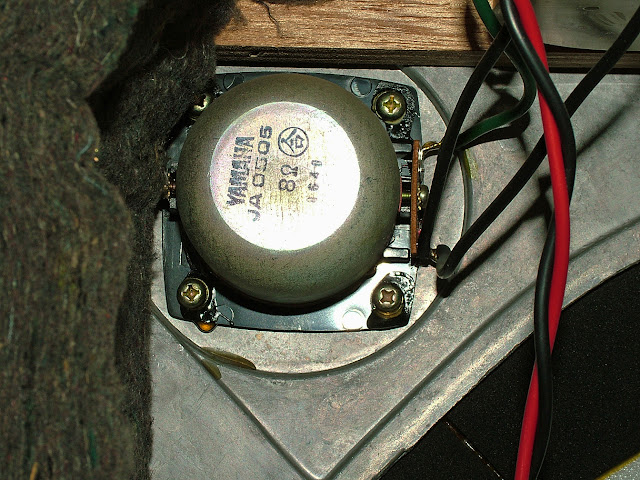Gentle reader,
First, I want to thank each and every one of you for taking the time to look at my humble blog. We just passed 80,000 page views! I am very grateful and humbly thank you for doing so.
It has been a while since I wrote a new post. Mainly because I have been avoiding going to thrift stores. One has so much more free time when NOT out shopping! The draw back is that I have had nothing to show you.
Well, today we went out to lunch at Fuddruckers. There is one now in our neighborhood and having fond memories of past meals there when the kids were, well, kid-ages, I suggested the two of us go. I even wore my "FUDDS U" T-shirt which the manager saw and wanted to know where I got it.
Anyway, I ate my very first meal made from game meat: an Elk burger. It was very good and their leanest meat. I have had Turkey and Ostrich burgers there in the past. Not very often do I eat any meat at all, having discovered how tasty and good for you grilled Salmon is.
So where am I going with this? My wife asked if we could go to "The Village" thrift store afterwards. So I agreed. It being a Saturday and very hot outside, I expected to find nothing but crowds. But I DID find something and I am listening to them right now: Vintage (circa 1973) Yamaha NS-13 speakers. (Oh and it was not crowded, either.)
"NS" stands for Natural Sound and many Yamaha products boast that title. However, this line of speakers were in the early generation of Yamaha NS products. And boy are they different!
Obviously, this is with the grille off. Note the aluminum structure? That is the framework for the bass driver. Note the odd shape and shallowness of said driver. I do not know what the white specs splattered on the black face are for, both of them have it and it appears to be some kind of paint. Factory? I don't know. Note the aluminum dome tweeter in the upper right. It too is mounted in the woofer's frame. That gray foam around the black is not what one would expect, i.e., the surround. I'm sure they put it there for a reason, but again, I do not know what it is. The nominal measurements of the "woofer" is 14" wide by 19" high. The cabinets measure 23" high by 16 1/2" wide by 7 1/2" deep.
They sold for $230 a piece in 1973 which is around $1,250 in today's money. That's a lot of coin.
Do you see the slots cut out of the rear of the top? They are on all four sides, but don't seem to have an acoustic purpose. Why they were put there is another mystery.
Here is with the grille in place. Looks like a lot of the speakers from that era, Black Walnut veneer, cloth grille, etc. I've always loved the look of Black Walnut wood.
The back, rather than the usual thick particle board or MDF material and structurally part of the cabinet is in fact thin hardboard wood product held on with eight screws and as you can see with fabric screen behind three openings.
Notice anything odd about the "cone" of the bass driver? It is made of Styrofoam. Very thin at that and covered in front with a thin black plastic of some kind. Note the thick batting on the inside walls, not fiberglass but still there to help direct/absorb the sound waves coming from the rear of the bass driver.
This is not my first encounter with a Styrofoam speaker, I found one at work that was large and square and designed to fit in place of an acoustic suspension ceiling tile. It puzzled me at the time, but many surfaces can and are made to reproduce sound.
It is nice that they came from the factory with three-way binding/banana terminals. Note the "L" pad, I set it to max because being 60, I need all the treble help that I can get. I have treble hearing the high notes......
Very large and robust crossover, isn't it? Note the thickness of the aluminum structure that holds the drivers. Note also the date on the capacitor?
I suspect the Japanese symbol on the tweeter means "8 ohms". Note that they glued the screws so they could not work loose. Also note that they twisted the wires that go to the bass driver. Significance? I haven't a clue.
Nice thick aluminum structure to support the steel magnet assembly for the bass driver's coil. The "cone" does not move very much. Nowadays, the measurable front to rear movement a woofer makes is called: Xmax and is measured in millimeters.
Here is a close up of one of the arms with YAMAHA cast into it and another Japanese symbol.
So, how do they sound? Surprisingly good! As I wrote above, I am listening to them right now. In fact an old Cal Tjader version of the Beatles Lady Godiva opened with cymbals and acoustic bass just now and it sounds SO good! I will be keeping and enjoying these for a while.
Not a lot of information about these odd speakers, but the audio bloggers repeatedly call them "sought after". Here is a link to one page with images and text to these speaker's brother:
Once again, thanks for making my blog such a success. Next time, I'll show you my toys. Yes, real toys, most of which the grandkids do not get to play with.
Scott












